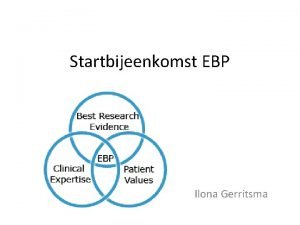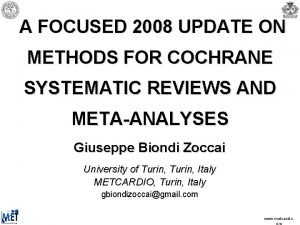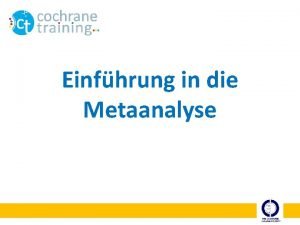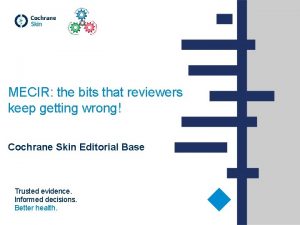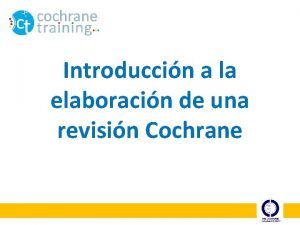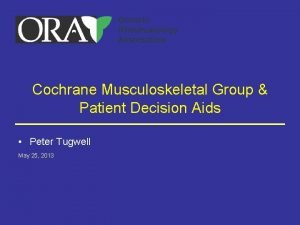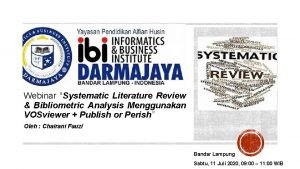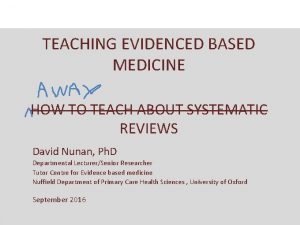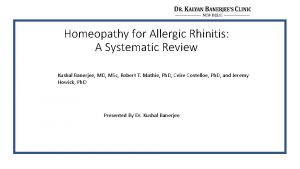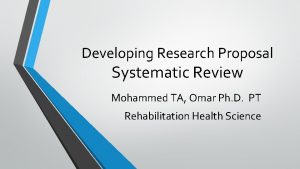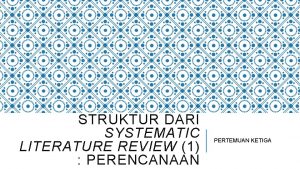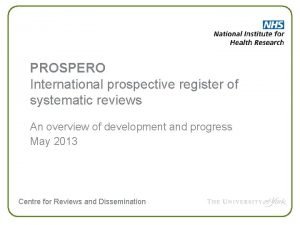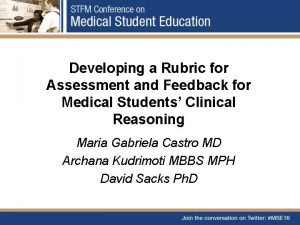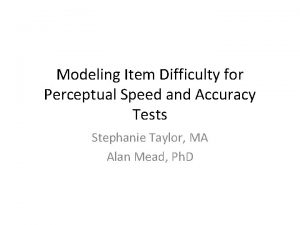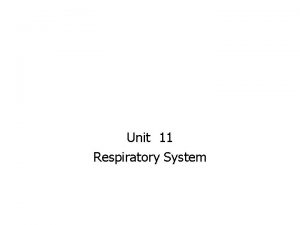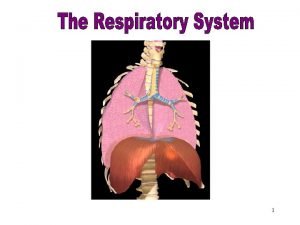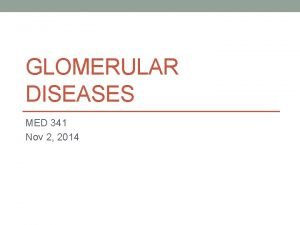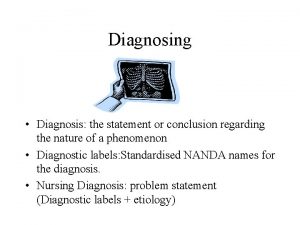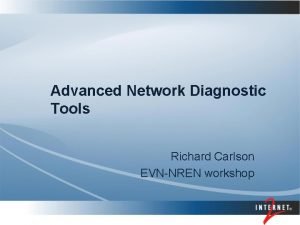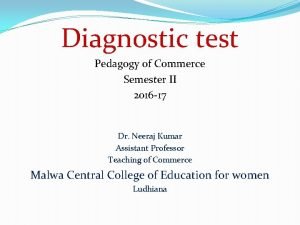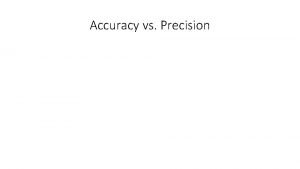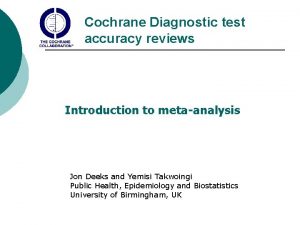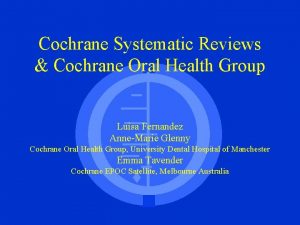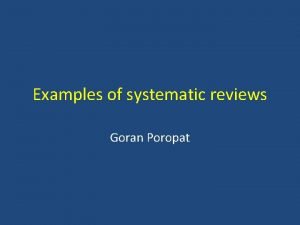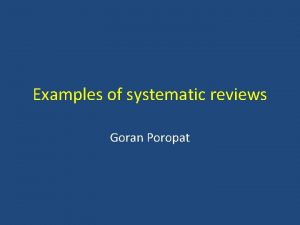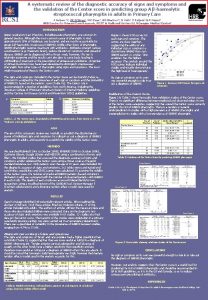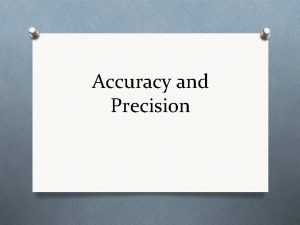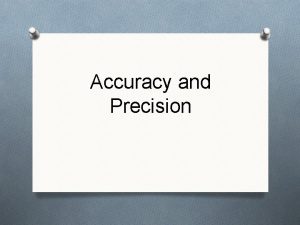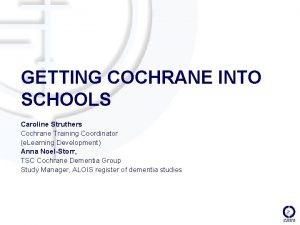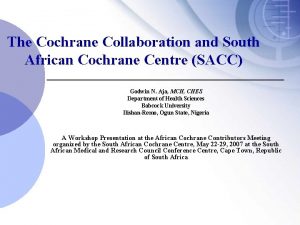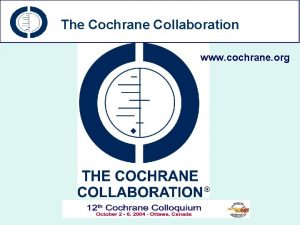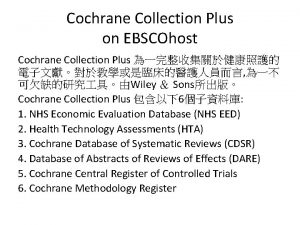THE COCHRANE SYSTEMATIC REVIEW OF DIAGNOSTIC TEST ACCURACY




























![OBJECTIVES PRIMARY To determine the dianostic accuracy of [index test] for detecting ……. To OBJECTIVES PRIMARY To determine the dianostic accuracy of [index test] for detecting ……. To](https://slidetodoc.com/presentation_image/39a844fa780e582a6132f29f0dc39f2d/image-29.jpg)





























- Slides: 58

THE COCHRANE SYSTEMATIC REVIEW OF DIAGNOSTIC TEST ACCURACY (DTA)

OUTLINE (THE) COCHRANE (COLLABORATION) THE COCHRANE LIBRARY RESEARCH QUESTION: - TITLE FORMULATION AND REGISTRATION - PROTOCOL DEVELOPMENT AND PUBLICATION - REVIEW DEVELOPMENT AND PUBLICATION - UPDATES

COCHRANE (THE COCHRANE COLLABORATION) WWW. COCHRANE. ORG

Cochrane Groups Cochrane Review Groups (CRGs) o the preparation and maintenance of systematic reviews; o each focused on a specific topic of health research. Cochrane Centres o support Cochrane contributors in their area. Cochrane Fields o focus on health care (e. g. primary care), type of consumer (children, older people) or provider (nursing). Cochrane Methods Groups o provide policy advice, and discuss development and implementation of methods used in the preparation of Cochrane Reviews.


INTERVENTION REVIEWS

What is Cochrane evidence and how can it help you? HTTP: //WWW. COCHRANE. ORG/WHAT-ISCOCHRANE-EVIDENCE

UNDERTAKING COCHRANE DTA REVIEW STEPS OF DTA REVIEW - IDENTIFY THE RELEVANT REVIEW GROUP - SEND A COMPLETED REVIEW PROPOSAL FOR - ONCE ACCEPTED, PROCEED AS PLANNED

DEFINE THE RESEARCH QUESTION AND ITS SUITABILITY IS THE TEST USABLE IN THE DIAGNOSTIC PATHWAY DEFINE OBJECTIVES (INCLUSION CRITERIA) PREPARE AND PUBLISH PROTOCOL

PROCEED TO REVIEW SEARCH AND SELECT STUDIES COLLECT DATA ASSESS BIAS AND APPLICABILITY ANALYSE AND PRESENT RESULTS INTERPRET RESULTS AND DRAW CONCLUSIONS IMPROVE, UPDATE, AND PUBLISH THE REVIEW

WHY IS TITLE FORMULATION (RESEARCH QUESTION) CRUCIAL FOR A DTA REVIEW?

INFORMATIVE TITLE FACILITATES DISSEMINATION - THE INDEX TEST EVALUATED AND COMPARED WITH - THE TARGET CONDITION - TYPE OF PARTICIPANTS

TITLE FORMULATION What is the diagnostic accuracy of ‘index test’ for diagnosing ‘target condition’ in ‘patient description’?

INDEX TEST ”A diagnostic test that is being evaluated against a reference standard test in a study of test accuracy” REFERENCE STANDARD “The test, combination of tests, or procedure that is considered the best available method of categorising participants in a study of DTA as having or not having a target condition” TARGET CONDITION(S)

TARGET CONDITION(S) THE CONDITION WE WANT THE INDEX TEST(S) TO DETECT IT WILL DETERMINE THE APPROPRIATE REFERENCE STANDARD MORE THAN ONE REFERENCE STANDARD MAY BE CONSIDERED APPROPRIATE

COMPONENTS OF A DTA TITLE/REVIEW QUESTION PARTICIPANTS PRESENTATION PRIOR TEST(S) (WILL DEPEND ON THE SETTINGS) INDEX TEST PURPOSE (to replace; triage; add-on) TARGET CONDITION(S)

…COMPONENTS OF A DTA REVIEW TITLE/ REVIEW QUESTION COMPARATOR TESTS REFERENCE STANDARD

INDEX TEST MAY BE NEW OR ALREADY USED IN CLINICAL PRACTICE HOW DOES IT PERFORM IN COMPARISON WITH (AN)OTHER TEST(S) COMPARISON OF THRESHOLDS

PURPOSE OF THE INDEX TESTS REPLACEMENT? ADD-ON? TRIAGE?

DIAGNOSTIC TEST ACCURACY REVIEWS


INTERVENTION REVIEWS HAVE DIRECT IMPACT ON PATIENT-ORIENTED OUTCOMES DTA REVIEWS SELDOM HAVE; DTA REVIEWS PROVIDE DECISIONS WHICH PATIENT TO TREAT AND WHICH NOT TO TREAT

DTA REVIEW TITLE AND PROTOCOL DEVELOPMENT Cochrane Handbook for Systematic Reviews of Diagnostic Test Accuracy http: //methods. cochrane. org/sdt/handbook-dtareviews


THE COCHRANE DTA REVIEW PROTOCOL STANDARD FORMAT! BACKGROUND (Why is this review important? key clinical issues? ) TARGET CONDITION BEING DIAGNOSED (frequency, severity, prognosis, possible treatment)

THE COCHRANE DTA REVIEW PROTOCOL STANDARD FORMAT! BACKGROUND …… INDEX TEST (details in any test variation, manufactureres, how many thresholds will be considered) CLINICAL PATHWAY (the existing pathway)

…. . THE COCHRANE DTA REVIEW PROTOCO PRIOR TESTS (yes or no) ROLE OF INDEX TESTS (in the pathway) ALTERNATIVE TESTS (used but will not be evaluated in your review) RATIONALE (why is the review needed? )

OBJECTIVES - ESTIMATE ACCURACY OF A TEST (AT A PARTICULAR THRESHOLD) - MAKE COMPARISONS BETWEEN TESTS CONCERNING THIER ACCURACY - UNDERSTAND WHY RESULTS OF STUDIES VARY
![OBJECTIVES PRIMARY To determine the dianostic accuracy of index test for detecting To OBJECTIVES PRIMARY To determine the dianostic accuracy of [index test] for detecting ……. To](https://slidetodoc.com/presentation_image/39a844fa780e582a6132f29f0dc39f2d/image-29.jpg)
OBJECTIVES PRIMARY To determine the dianostic accuracy of [index test] for detecting ……. To estimate the test accuracy for each test at pre-specified thresholds SECONDARY. . Related to the investigation of heterogeneity between study results that may be due to different study design; sample size; clinical setting; spectrum of the disease; cut-off points etc

METHODS CRITERIA FOR CONSIDERING STUDIES FOR THIS REVI TYPES OF STUDIES (cross-sectional study) prospective, retrospective, or both how and where participants were recruited: as a consecutive series in primary care? . . State restrictions! PARTICIPANTS (for whom the test would be applicable; sex, age, settings) State restrictions! INDEX TESTS (the tests to be evaluated; single or multiple tests; provide details for each test)

METHODS …CRITERIA FOR CONSIDERING STUDIES FOR THIS REVIE TARGET CONDITIONS (the target desease or disease stage the index test is going to detect; or the ability of the test to differentiate between several target conditions (if so, list these) REFERENCE STANDARDS (one or more? Are all applicable or not? State exclusion criteria!)

SEARCH METHODS FOR IDENTIFICATION OF STUDIES ELECTRONIC SEARCHES SEARCHING OTHER RESOURCES DESIGN SEARCH STRATEGIES. REMEMBER DTA STUDIES ARE POORLY INDEXED. MINIMUM TO INCLUDE: TARGET CONDITION AND INDEX TEST(S)

MEDLINE 1990 to the date of search. # 1 'nuclear magnetic resonance imaging': ab, ti # 2 'nuclear magnetic resonance imaging'/exp # 3 'magnetization transfer imaging': ab, ti # 4 mrcp: ab, ti OR mri: ab, ti OR nmr: ab, ti AND imaging: ab, ti OR fmri: ab, ti Combination of # 5 mrcp: ab, ti OR mri: ab, ti OR 'nmr imaging': ab, ti magnetic resonance cholangiopancreatography OR fmri: ab, ti # 6 cholangiopancreatograph*: ab, ti and #7 #1 OR #2 OR #3 OR #4 OR #5 conventional magnetic resonance imaging #8 #6 OR #7 for the diagnosis of #9 'digestive system diseases'/exp #10 'biliary tract': ab, ti bile duct stenosis #11 'bile duct': ab, ti #12 'biliary duct': ab, ti #13 'jaundice': ab, ti #14 'stenosi': ab, ti OR 'strictur': ab, ti OR 'narrow': ab, ti OR 'explore': ab, ti OR 'exploration': ab, ti #15 'biliary stricture': ab, ti #16 #10 OR #11 OR #12 #17 #14 AND #16 #18 #13 OR #15 OR #17 #19 #9 OR #18 #20 #8 AND #19

DATA COLLECTION AND ANALYSIS SELECTION OF STUDIES DATA EXTRACTION AND MANAGEMENT PAIRED OUTCOMES: SENSITIVITIES (SE) AND SPECIFICITES (SP) The truth (reference standard) With disease Test + S E Without disease TP (no of pts) FP (no of pts) - FN (no of pts) Total (no of pts) RECEIVER OPERATING CHARACTERISTIC CURVE (ROC) S P


SROC PLOT

. . DATA COLLECTION AND ANALYSIS. SELECTION OF STUDIES …DATA EXTRACTION AND MANAGEMENT ……………. . HETEROGENEITY IS EXPECTED STUDY DESIGN ISSUES OF BIAS RANDOM-EFFECTS BY DEFAULT YOU NEED EXTERNAL SOFTWARE AND A STATISTICIAN!

……. . DATA COLLECTION AND ANALYSIS ASSESSMENT OF METHODOLOGICAL QUALITY (QUADAS 2) DOMAIN PARTICIPANT SELECTION FLOW AND TIMING INDEX TEST REFERENCE STANDARD Signalling questions 3 questions and criteria Yes, no, or unclear 2 q Bias risk Selection of participants; index test(s); reference standard; participants’ flow High, low, unclear Concerns about applicability 4 q Do they match the Does it differ Does the target condi- review question from the tion as defined by the review reference standard question match the review question High, low, unclear

SENSITIVITY ANALYSES We will perform sensitivity analyses by considering only cross-sectional design studies (i. e. , excluding case-control studies), and studies assessed as low risk of bias ASSESSMENT OF REPORTING (PUBLICATION) BIAS (write about existing tests for reporting bias) ACKNOWLEDGEMENTS CONTRIBUTION OF AUTHORS DECLARATIONS OF INTEREST PUBLISHED NOTES


SO, WHY A PROTOCOL? Ø ENSURES THAT THE RESEARCH QUESTION HAS BEEN WELL-THOUGHT THROUGH Ø ENSURES THE METHODOLOGY THROUGH PRESPECIFICATION OF METHODS - REDUCES BIAS Ø PEER-REVIEWED BEFORE PUBLICATION

SO, WHY A PROTOCOL? REDUCES THE RISK OF DUPLICATION OF EFFORT

THANK YOU!

Transient elastography for diagnosis of stages of hepatic fibrosis and cirrhosis in people with alcoholic liver disease Objective To determine the diagnostic accuracy of transient elastography for diagnosis and staging hepatic fibrosis in people with alcoholic liver disease when compared with liver biopsy. In addition, to identify the optimal cut-off values for differentiating the five stages of hepatic fibrosis. Pavlov CS, Casazza G, Nikolova D, Tsochatzis E, Burroughs AK, Ivashkin VT, Gluud C. Transient elastography for diagnosis of stages of hepatic fibrosis and cirrhosis in people with alcoholic liver disease. Cochrane Database of Systematic Reviews 2015, Issue 1. Art. No. : CD 010542. DOI: 10. 1002/14651858. CD 010542. pub 2.

Index tests Transient elastography, a non-invasive test, measuring liver stiffness in kilo. Pascals (k. Pa). Describe recommended technical parameters assumed to ensure the validity of the transient elastography result for every participant in the single studies… What types of participants will you consider data from? (e. g. the full set of the data that we have described) Is the test recommended for all? What are the factors that may influence the success of transient elastography investigation? ( e. g. experience of the operator and body mass index of the person. Liver stiffness measurement depending on the grade of necro-inflammation and grade of steatosis. . etc)

Target conditions The presence of hepatic fibrosis in people with alcoholic liver disease. Based on the METAVIR histopathological score for interpreting liver biopsy, there are five stages of hepatic fibrosis (Table 1). • F 0: no fibrosis. • F 1: mild fibrosis. • F 2: significant fibrosis. • F 3: severe fibrosis. • F 4: cirrhosis. We dichotomised the hepatic fibrosis estimated by the METAVIR score as follows: - people with METAVIR score of F 1 or worse were considered ’diseased’ and people with METAVIR score of F 0 are considered ’non-diseased’; etc

Participants The studies have to include participants of any sex and ethnic origin, above 16 years old, and diagnosed with alcoholic liver disease. The participants could have been hospitalised or managed as outpatients. The diagnosis of alcoholic liver disease in the study participants has to be established based on registered history of excessive intake of alcohol of sufficient duration and quantity together with clinical evidence of liver disease expressed with physical signs at examination and followed by laboratory evidence of liver disease. To ascertain the diagnosis of alcoholic liver disease and study the presence or absence of hepatic fibrosis or cirrhosis, the studies had to perform both transient elastography and liver biopsy.

Reference standards Liver biopsy is the reference standard that is obtained by percutaneous needle techniques, transjugular method, ultrasound-guided fine-needle, or surgical specimens (REF; REF). Liver biopsy is the only existing reference standard so far for diagnosing hepatic fibrosis stages in people with alcoholic liver disease. Specimens of liver tissue with a mean length of at least 15 mm and at least seven portal tracts are among the factors that can provide reliable morphological staging of hepatic fibrosis and grading of inflammation (REF). … Describe what will you do if liver biopsy samples were reported with any of the semiquantitative scores, that is, METAVIR (REF), Knodell (REF), Ishak (REF), etc.

Lateral flow urine lipoarabinomannan assay for detecting active tuberculosis in HIV-positive adults Primary objectives To assess the accuracy of LF-LAM for the diagnosis of active TB disease in HIV-positive adults who have signs and symptoms suggestive of TB (TB diagnosis). To assess the accuracy of LF-LAM as a screening test for active TB disease in HIV-positive adults irrespective of signs and symptoms suggestive of TB (TB screening). Shah M, Hanrahan C, Wang ZY, Dendukuri N, Lawn SD, Denkinger CM, Steingart KR. Lateral flow urine lipoarabinomannan assay for detecting active tuberculosis in HIV-positive adults. Cochrane Database of Systematic Reviews 2016, Issue 5. Art. No. : CD 011420. DOI: 10. 1002/14651858. CD 011420. pub 2.

Secondary objectives To compare the diagnostic accuracy of LF-LAM and existing tests, sputum smear microscopy or sputum Xpert® MTB/RIF, as well as determine the diagnostic accuracy of LF-LAM when added to existing tests. To investigate heterogeneity of test accuracy in the included studies. Possible sources of heterogeneity include CD 4 count and clinical setting (inpatient versus outpatient setting).

Index test(s) The lateral flow urine lipoarabinomannan assay (LF-LAM) is a commercially available point-of-care test for active TB (Alere Determine. TM TB LAM Ag, Alere Inc, Waltham, MA, USA). The test detects lipoarabinomannan (LAM), a lipopolysaccharide present in mycobacterial cell walls, which is released from …. . and appears to be present only in people with active TB disease.

Reference standards We will require studies to diagnose TB using at least one of the following two reference standards. • Microbiological reference standard: • we define 'TB' as a positive M. tuberculosis culture or nucleic acid amplification test (NAAT); • we define 'not TB' as a negative M. tuberculosis culture and NAAT (if performed). • Composite reference standard that includes M. tuberculosis culture together with at least one of the following components: NAAT, smear, or clinical findings: • we define 'TB' as (1) a positive culture, or (2) a positive NAAT, or (3) a positive smear, or (4) a clinical decision to start TB treatment, and, after at least one month of follow-up, the participant was diagnosed as having TB; • we define 'not TB' as a negative culture and NAAT (if performed), no TB treatment given, and resolution of signs and symptoms at follow-up.

Contrast-enhanced ultrasound (CEUS) compared with contrast-enhanced computed tomography (CECT), magnetic resonance imaging (MRI), and Fluro-18 deoxyglucose positron emission tomographycomputed tomography (18 F-FDG PET-CT) for diagnosing liver metastases in people with newly diagnosed colorectal cancer OBJECTIVE: To compare the accuracy of CEUS, CECT, MRI, and 18 FFDG PET-CT for diagnosing liver metastases in people with newly-diagnosed colorectal cancer.

LUND M, BJERRE TA, GRØNBÆK H, MORTENSEN F, KRAGH ANDERSEN P. CONTRAST-ENHANCED ULTRASOUND COMPARED WITH COMPUTED TOMOGRAMPHY, MAGNETIC RESONANCE IMAGING, AND POSITRON EMISSION TOMOGRAPHY FOR DIAGNOSING LIVER METASTASES IN PEOPLE WITH NEWLY DIAGNOSED COLORECT AL CANCER. COCHRANE DATABASE OF SYSTEMATIC REVIEWS 2016, ISSUE 10. ART. NO. : CD 012388. DOI: 10. 1002/14651858. CD 012388

Index tests The index tests are CEUS, CECT, MRI, and 18 F-FDG PET-CT. Target conditions The clinical target condition of this review is colorectal liver metastases in people with newly-diagnosed colorectal cancer. Reference standards The reference standard should consist of laparotomy including palpation, intraoperative ultrasound (IOUS), and biopsy test results, or a pathological examination of surgically-removed specimens. This approach is considered to be the most accurate. However, this approach is only possible in people with resectable liver metastases. People with non-resectable liver metastases need to be verified by biopsy results.

If all of the index tests give negative results in the same study participant, it will not be possible to verify this with the described reference standards, and the participant should be subjected to adequate follow-up for at least three months. At the end of the three months, the participant should once more be evaluated with the same modalities as before, to verify the status of no liver metastases. If the participant is diagnosed with liver metastases after three months, and this is verified by the reference standard, then the first tests should be considered as false negative. The participants in the same study should all be evaluated by the same reference standard in order to avoid differential verification bias, but because of the facts described above it is necessary to accept more than one reference standard in the same study. However, it is absolutely necessary that all participants in the same category (people with resectable liver metastases, people with non-resectable liver metastases, and people with no liver metastases) are evaluated by the same reference standard.

…. DATA COLLECTION AND ANALYSIS STATISTICAL ANALYSIS AND DATA SYNTHESIS We will create a 2 x 2 table of the diagnostic accuracy of XX plus XX for diagnosing the presence, or the site, or the aetiology (benign versus malignant) of XX. We will report SE, SP, and LR+ and LR- with their 95% CI for each primary study. We will perform a graphical descriptive analysis of the included studies with forest plots (of SE and SP) and with graphical representation of the studies in the ROC space (plot of SE versus 1 - SP). We will fit the bivariate model and use the results to calculate the pooled estimates of sensitivity and specificity (mean operating point). If primary studies present non-evaluable results about the index test, we will create a 3 x 2 table of diagnostic accuracy of index test for xx. We will then adopt the intention-todiagnose approach to build 2 x 2 tables for meta-analyses. According to this approach, we will include non-evaluable results either in the false-negative or false-positive cell of the 2 x 2 table, as appropriate.

…. DATA COLLECTION AND ANALYSIS INVESTIGATIONS OF HETEROGENEITY We will investigate heterog. . in a descriptive way (forest plots for various subgroups of studies), as well as in a more formal way, by adding co-variates to the bivariate model. We consider the following as potential sources of heterogeneity. E. g. - xx technological differences in the xxx - type of reference standard: - surgical types: represented by surgical exploration, histopathological findings; and - clinical and other imaging tests: represented by clinical follow-up and xxx - clinical context (studies with people not undergoing surgery versus studies with people undergoing surgery). - participants submitted to prior tests xxxx before the index test or reference standard - type of disease that led to stenosis.
 Cochrane rapid review
Cochrane rapid review Nader amin-salehi
Nader amin-salehi What is inclusion and exclusion
What is inclusion and exclusion Narrative review vs systematic review
Narrative review vs systematic review 5 stappen ebp nursing
5 stappen ebp nursing Mark wilson cochrane
Mark wilson cochrane Cochrane risk of bias table template
Cochrane risk of bias table template Níveis de evidência científica cochrane
Níveis de evidência científica cochrane Cochrane metaanalyse
Cochrane metaanalyse Cochrane training
Cochrane training Marianne cochrane
Marianne cochrane Euan cochrane
Euan cochrane Mecir cochrane
Mecir cochrane Vavasseur
Vavasseur Sesgo de performance
Sesgo de performance Tabla riesgo de sesgo cochrane
Tabla riesgo de sesgo cochrane Cochrane lions football
Cochrane lions football Cochrane wiley
Cochrane wiley Cochrane
Cochrane Cochrane library介紹
Cochrane library介紹 Manual cochrane
Manual cochrane Cochrane musculoskeletal group
Cochrane musculoskeletal group Literature review dalam penelitian
Literature review dalam penelitian Qfas systematic review
Qfas systematic review Dr. kushal banerjee
Dr. kushal banerjee Prospero systematic review
Prospero systematic review Research proposal systematic review
Research proposal systematic review Contoh critical appraisal jurnal systematic review
Contoh critical appraisal jurnal systematic review Anna neary
Anna neary Struktur literature review
Struktur literature review Nihr prospero
Nihr prospero Systematic review in history taking
Systematic review in history taking Perceptual speed and accuracy examples
Perceptual speed and accuracy examples Diagnostic test of respiratory system
Diagnostic test of respiratory system Rhinorrhea
Rhinorrhea Leap 360 geometry interim test form 1 answer key
Leap 360 geometry interim test form 1 answer key Diagnostic test meaning
Diagnostic test meaning It test the basic functionality of computer ports
It test the basic functionality of computer ports Diagnostic positions test normal findings
Diagnostic positions test normal findings Diagnostic formative and summative assessment
Diagnostic formative and summative assessment Conclusion of diagnostic test
Conclusion of diagnostic test Network diagnostic test
Network diagnostic test Syphilis diagnostic test
Syphilis diagnostic test Diagnostic test in education
Diagnostic test in education Algebra 2 unit test
Algebra 2 unit test Hát kết hợp bộ gõ cơ thể
Hát kết hợp bộ gõ cơ thể Ng-html
Ng-html Bổ thể
Bổ thể Tỉ lệ cơ thể trẻ em
Tỉ lệ cơ thể trẻ em Voi kéo gỗ như thế nào
Voi kéo gỗ như thế nào Chụp phim tư thế worms-breton
Chụp phim tư thế worms-breton Bài hát chúa yêu trần thế alleluia
Bài hát chúa yêu trần thế alleluia Môn thể thao bắt đầu bằng từ chạy
Môn thể thao bắt đầu bằng từ chạy Thế nào là hệ số cao nhất
Thế nào là hệ số cao nhất Các châu lục và đại dương trên thế giới
Các châu lục và đại dương trên thế giới Cong thức tính động năng
Cong thức tính động năng Trời xanh đây là của chúng ta thể thơ
Trời xanh đây là của chúng ta thể thơ Mật thư anh em như thể tay chân
Mật thư anh em như thể tay chân Phép trừ bù
Phép trừ bù




